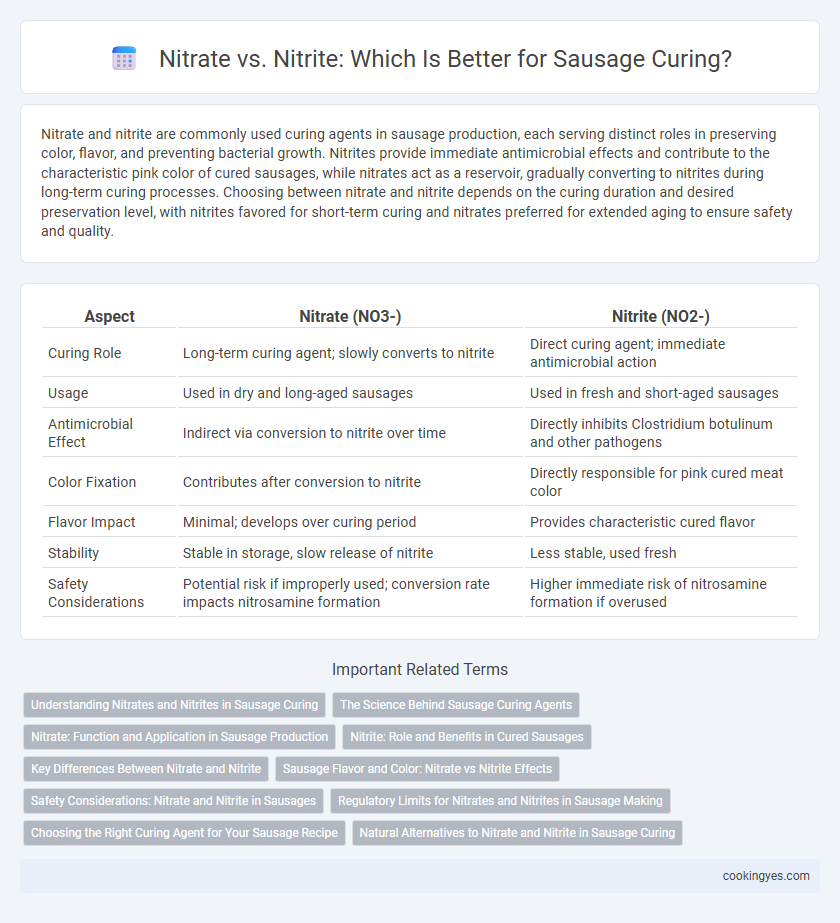Nitrate and nitrite are commonly used curing agents in sausage production, each serving distinct roles in preserving color, flavor, and preventing bacterial growth. Nitrites provide immediate antimicrobial effects and contribute to the characteristic pink color of cured sausages, while nitrates act as a reservoir, gradually converting to nitrites during long-term curing processes. Choosing between nitrate and nitrite depends on the curing duration and desired preservation level, with nitrites favored for short-term curing and nitrates preferred for extended aging to ensure safety and quality.
Table of Comparison
| Aspect | Nitrate (NO3-) | Nitrite (NO2-) |
|---|---|---|
| Curing Role | Long-term curing agent; slowly converts to nitrite | Direct curing agent; immediate antimicrobial action |
| Usage | Used in dry and long-aged sausages | Used in fresh and short-aged sausages |
| Antimicrobial Effect | Indirect via conversion to nitrite over time | Directly inhibits Clostridium botulinum and other pathogens |
| Color Fixation | Contributes after conversion to nitrite | Directly responsible for pink cured meat color |
| Flavor Impact | Minimal; develops over curing period | Provides characteristic cured flavor |
| Stability | Stable in storage, slow release of nitrite | Less stable, used fresh |
| Safety Considerations | Potential risk if improperly used; conversion rate impacts nitrosamine formation | Higher immediate risk of nitrosamine formation if overused |
Understanding Nitrates and Nitrites in Sausage Curing
Nitrates and nitrites are essential chemical compounds used in sausage curing to inhibit bacterial growth and enhance flavor and color. Nitrates serve as a long-term source that gradually converts into nitrites during the curing process, while nitrites act directly to prevent Clostridium botulinum and provide the characteristic pink hue. Understanding the distinct roles and conversion of nitrates to nitrites is crucial for safe and effective sausage preservation, balancing food safety with texture and taste.
The Science Behind Sausage Curing Agents
Nitrate and nitrite play crucial roles in sausage curing by inhibiting bacterial growth, particularly Clostridium botulinum, ensuring food safety. Nitrite directly interacts with myoglobin in meat, stabilizing its color and giving cured sausage its characteristic pink hue while also developing flavor. Nitrate acts as a reservoir, gradually converting to nitrite through microbial action during extended curing processes, providing prolonged preservation and consistency in cured sausages.
Nitrate: Function and Application in Sausage Production
Nitrate serves as a critical curing agent in sausage production by inhibiting the growth of harmful bacteria such as Clostridium botulinum, ensuring product safety during extended storage. Its slow conversion to nitrite through bacterial action allows for prolonged preservation and develops characteristic cured meat flavors and color. Nitrate is especially valued in dry or long-aged sausages where gradual curing is essential for texture and flavor development.
Nitrite: Role and Benefits in Cured Sausages
Nitrite plays a crucial role in cured sausages by inhibiting the growth of harmful bacteria such as Clostridium botulinum, enhancing food safety. It contributes to the distinctive pink color and characteristic flavor of cured meats, while also acting as an antioxidant to extend shelf life. The controlled use of nitrite ensures consistent curing effects and improves the overall quality and preservation of sausages.
Key Differences Between Nitrate and Nitrite
Nitrate and nitrite are essential curing agents in sausage production, with nitrate acting as a long-term preservative that gradually converts to nitrite through bacterial action. Nitrite directly inhibits bacterial growth, particularly Clostridium botulinum, ensuring food safety and contributing to the characteristic pink color and flavor of cured sausages. Understanding the distinct roles and conversion process of nitrate to nitrite is crucial for optimizing cure times and maintaining product quality in sausage manufacturing.
Sausage Flavor and Color: Nitrate vs Nitrite Effects
Nitrite enhances sausage flavor by providing a distinctive cured taste and contributes to the characteristic pink color that defines traditional cured sausages, while nitrate itself is initially flavorless and relies on bacterial conversion to nitrite for flavor development. Nitrite's direct interaction with myoglobin stabilizes the meat color, preventing the brownish hue typical of uncured products, resulting in a more appealing and consistent appearance. Nitrate acts mainly as a reservoir for nitrite, extending curing duration but having minimal immediate impact on flavor and color compared to nitrite's immediate effects.
Safety Considerations: Nitrate and Nitrite in Sausages
Nitrate and nitrite are commonly used curing agents in sausages to inhibit bacterial growth and enhance color and flavor, with nitrite providing faster antimicrobial effects. Safety considerations focus on proper dosage, as excessive nitrite can form harmful nitrosamines, which are carcinogenic. Regulatory guidelines limit nitrite levels in cured meats to ensure consumer safety while maintaining effective preservation.
Regulatory Limits for Nitrates and Nitrites in Sausage Making
Regulatory limits for nitrates and nitrites in sausage making are strictly enforced to ensure food safety and prevent toxic exposure. The FDA and EFSA typically set maximum allowable concentrations, such as 200 ppm for sodium nitrite and 500 ppm for sodium nitrate, to minimize the risk of nitrosamine formation. Compliance with these limits is critical for sausage manufacturers to maintain product quality and consumer health standards.
Choosing the Right Curing Agent for Your Sausage Recipe
Nitrate and nitrite are essential curing agents that preserve sausage by inhibiting bacterial growth and enhancing flavor and color. Nitrite acts faster and provides immediate antimicrobial effects, making it ideal for fresh sausages or short curing times, while nitrate slowly converts to nitrite, suitable for long-term curing processes. Selecting the appropriate curing agent depends on the sausage type, desired curing duration, and safety considerations to ensure optimal preservation and taste.
Natural Alternatives to Nitrate and Nitrite in Sausage Curing
Natural alternatives to nitrate and nitrite in sausage curing include celery powder, beetroot extract, and cultured dextrose, which provide similar antimicrobial and preservative effects without synthetic additives. These natural curing agents contain naturally occurring nitrates that convert to nitrites during fermentation, maintaining the characteristic pink color and preventing spoilage in sausages. Incorporating such plant-based sources supports clean-label trends and appeals to consumers seeking healthier, additive-free meat products.
Nitrate vs nitrite for sausage curing Infographic

 cookingyes.com
cookingyes.com